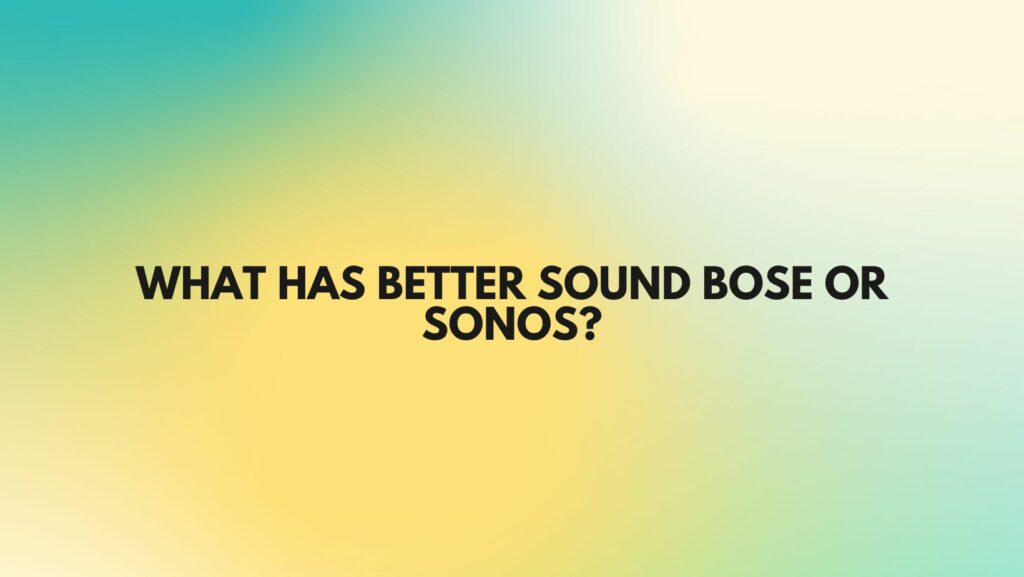In the realm of audio excellence, Bose and Sonos stand as stalwarts, revered for their commitment to delivering unparalleled sound quality and immersive experiences. As consumers seek the perfect balance between performance, versatility, and aesthetics, the perennial question persists: Which brand offers superior sound — Bose or Sonos? Delving into the intricacies of their audio technologies and product offerings unveils a nuanced exploration of sound quality in the Bose and Sonos ecosystems.
Understanding Sound Quality: Bose vs. Sonos At the core of the Bose and Sonos experience lies a shared dedication to pushing the boundaries of audio innovation, leveraging cutting-edge technologies to create captivating soundscapes that resonate with listeners on a profound level. To assess their respective strengths and weaknesses, it’s essential to examine key factors that influence sound quality:
- Engineering and Acoustics: Bose’s legacy in audio engineering is synonymous with precision and clarity, epitomized by its proprietary speaker designs and signal processing algorithms. Bose speakers are renowned for their balanced sound profiles, delivering rich bass, clear midrange, and crisp highs across various genres and audio formats.
On the other hand, Sonos leverages a holistic approach to acoustics, meticulously tuning each speaker component to achieve optimal performance. With an emphasis on room-filling sound and immersive listening experiences, Sonos speakers prioritize clarity and detail, accentuating nuances in music, movies, and podcasts with remarkable fidelity.
- Speaker Configuration and Audio Formats: Both Bose and Sonos offer a diverse range of speakers and sound systems tailored to diverse preferences and use cases. Bose’s lineup includes compact Bluetooth speakers, versatile soundbars, and high-fidelity home audio systems, each designed to deliver exceptional sound quality in different environments.
Similarly, Sonos offers a comprehensive ecosystem of wireless speakers, soundbars, and subwoofers that seamlessly integrate into multi-room audio setups. With support for popular audio formats such as Dolby Atmos and Hi-Res Audio, Sonos speakers elevate the listening experience, transporting audiences into the heart of the action with immersive surround sound.
- User Experience and Integration: In an increasingly interconnected world, the user experience extends beyond sound quality to encompass ease of use, connectivity options, and integration with smart home ecosystems. Both Bose and Sonos prioritize simplicity and convenience, offering intuitive interfaces, wireless connectivity, and compatibility with popular streaming services and voice assistants.
While Bose emphasizes seamless integration with its proprietary Bose Music app and voice-enabled smart speakers, Sonos distinguishes itself with its open-platform approach, allowing users to control their speakers via the Sonos app, voice commands, or third-party services like Spotify and Apple AirPlay.
Conclusion: In the timeless debate over sound quality, Bose and Sonos emerge as formidable contenders, each exemplifying excellence in audio engineering, design aesthetics, and user experience. While Bose’s legacy of innovation and precision engineering resonates with discerning audiophiles, Sonos’ emphasis on versatility and ecosystem integration captivates enthusiasts seeking immersive, connected listening experiences.
Ultimately, the choice between Bose and Sonos hinges on individual preferences, lifestyle considerations, and budget constraints. Whether it’s the refined sound signature of Bose or the immersive soundstage of Sonos, both brands continue to redefine the boundaries of audio excellence, enriching lives and transforming the way we experience music, movies, and more.


